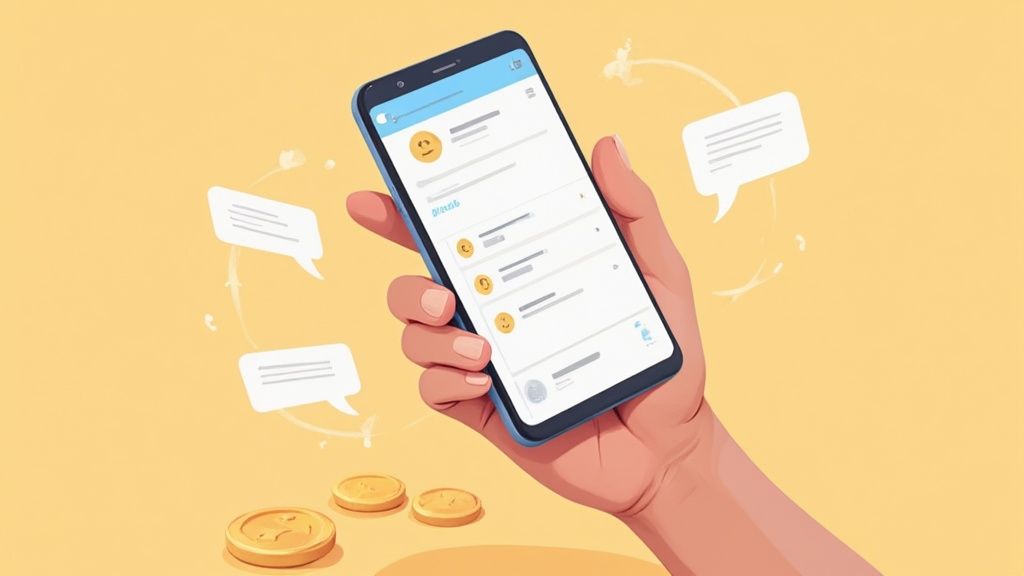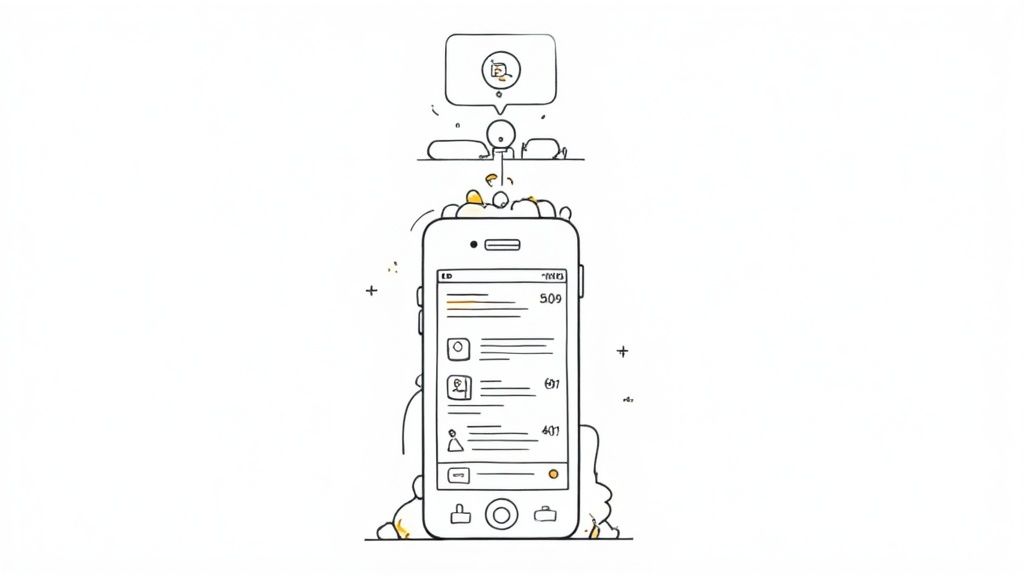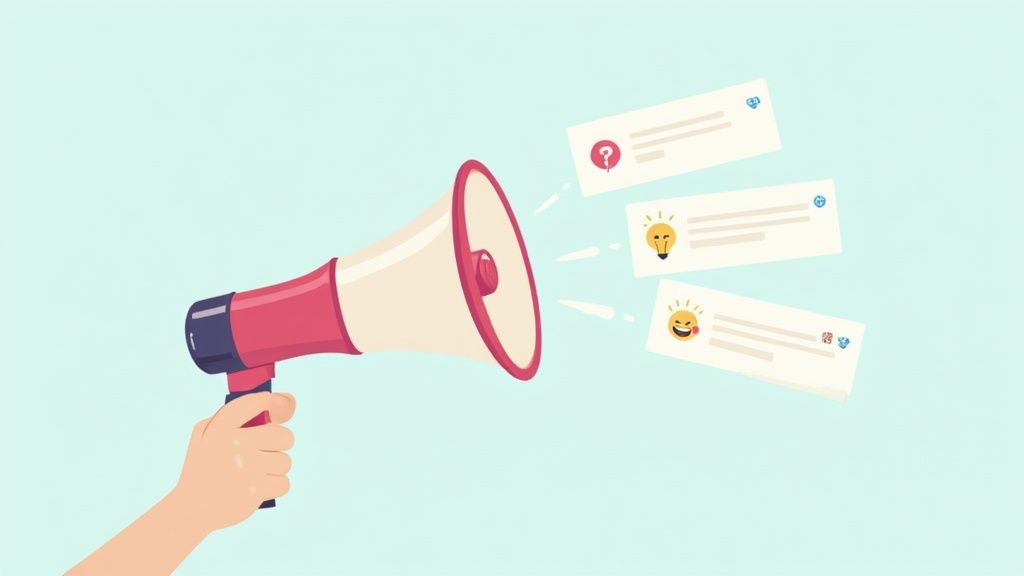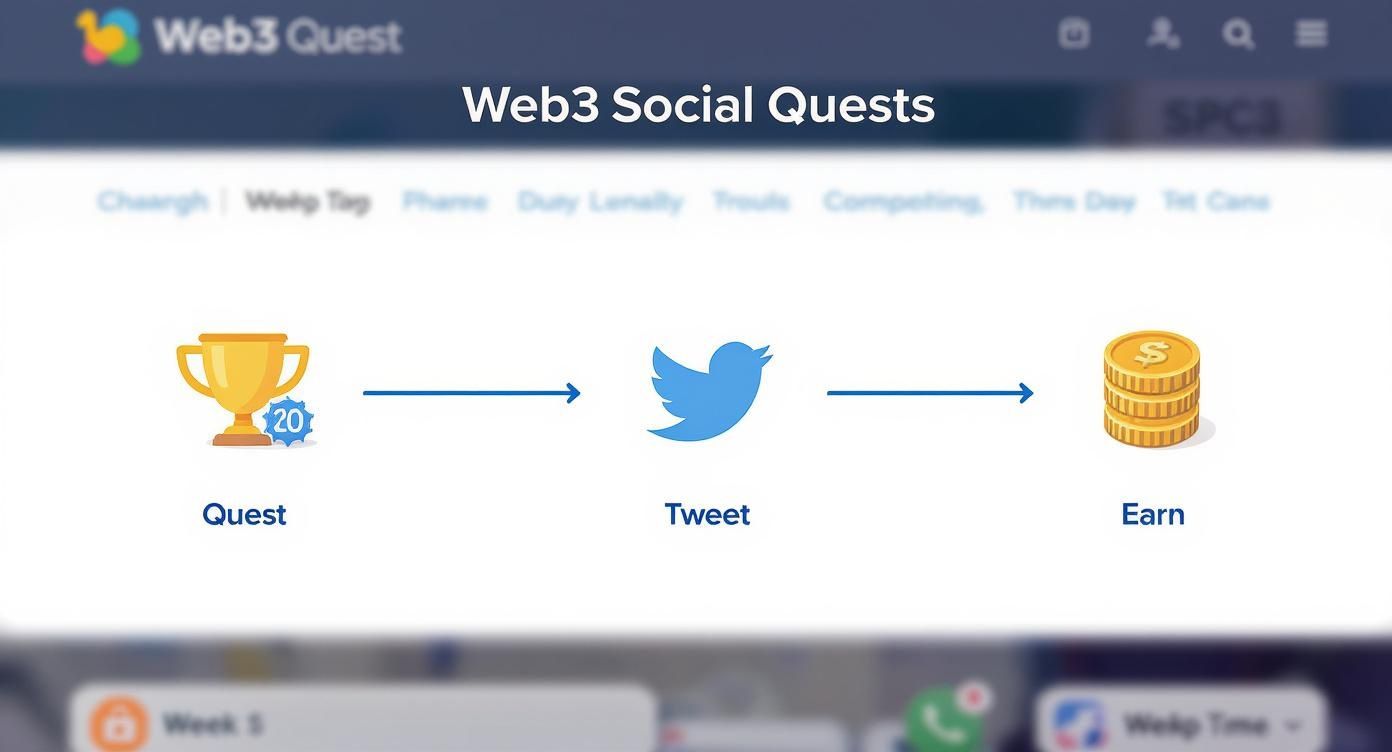How to Retweet with Comment and Boost Engagement

Knowing how to add a comment to a retweet is pretty straightforward. Instead of just hitting "Repost," you tap "Quote," type your own thoughts, and then send it out. This one extra step completely changes the game, turning a simple share into a real conversation starter that puts your own spin on things.
Think of it this way: a basic retweet is like nodding along in a meeting, but a Quote Tweet is like grabbing the mic to add your own two cents.
Why Quote Tweeting Is Your Secret Engagement Weapon

Just reposting someone else's content is fine, but it doesn't add anything new to the conversation. A Quote Tweet, though? That’s your opportunity to transform a simple share into a powerful piece of content that shows off your brand's personality, your expertise, or even just your sense of humor.
Adding your own commentary is a seriously smart move. You're not just echoing someone else's message; you're building on it. Social media algorithms love this because it creates layers of interaction and sparks real back-and-forth.
Adding Context and Starting Conversations
A Quote Tweet is the perfect way to add that little bit of context the original post might be missing. For instance, if a major tech account tweets about a new software update, you could Quote Tweet it and add, "This looks great, but remember to back up your data first! Hearing some users are seeing minor bugs after the install." Instantly, you've provided real value to your followers.
It also flips the script from a one-way announcement to a two-way street. Instead of just sharing a news headline, you could ask your audience a question like, "This is a massive development in AI. How do you all think this will affect creative jobs?"
A Quote Tweet does more than just share; it invites a response. It signals to your audience and the algorithm that you're here to engage, not just to echo.
Boosting Your Visibility
Retweeting with a comment lets you inject your own perspective, which almost always leads to better conversations. Even with all the platform changes, engagement data consistently shows that interactive posts get a serious visibility boost. The algorithm tends to favor replies and commented retweets because they keep people on the platform longer. If you're curious about the numbers behind this, it's worth checking out some recent Twitter engagement statistics.
Ultimately, this feature is about making the content yours. Whether you’re offering a sharp analysis, cracking a perfectly timed joke, or sharing a personal story connected to the original tweet, you're giving people a new reason to pay attention to you.
Simple Retweet vs Quote Tweet A Quick Comparison
Confused about when to use which? Here’s a breakdown of the two ways to share a tweet and the strategic impact of each choice.
| Feature | Simple Retweet | Retweet With Comment |
|---|---|---|
| Your Voice | Your followers see the original tweet from its author. | Your commentary appears above the original tweet. |
| Visibility | Shows up in your followers' feeds, but easily missed. | Creates a new tweet, boosting its chances of being seen. |
| Engagement | Passive. People can like/reply to the original tweet. | Active. Invites direct replies and conversations with you. |
| Best For | Quickly sharing news or endorsing a message you fully agree with. | Adding context, asking questions, or starting a debate. |
Choosing between a simple retweet and a Quote Tweet really comes down to your goal. Are you just trying to amplify a message, or are you trying to start a discussion and build your own voice?
A Super Quick Guide to Quote Tweeting on X

Ready to jump into the conversation and add your own two cents? Learning how to retweet with a comment (or "quote tweet" as it's often called) is a breeze, whether you're on your phone or your computer. The steps are pretty much the same everywhere.
Find a tweet you want to share and hit that circular arrow icon – the repost button. That's your starting point.
Quote or Repost? Here's the Difference
Instead of just one option, you'll see a little menu pop up. This is where you decide how you want to share.
- Repost: Think of this as the classic retweet. Hit this, and the original tweet just shows up on your timeline as is. Simple, no commentary from you.
- Quote: This is what we're here for. Tapping "Quote" opens up a new screen, letting you type your own thoughts above the original tweet.
The screenshot here lays it out perfectly. Once you hit "Quote," you get a fresh space to work with.
The best part? Your comment gets the standard 280 characters, but the original tweet you're quoting doesn't count against that limit. You get all that space for your own take.
Sending Your Quote Tweet Out Into the World
Once you've typed out your brilliant commentary, just tap the "Post" button. Your followers will see your comment first, with the original tweet embedded right below it. You've essentially created a new piece of content, and now people will reply to you, not just the original poster.
It’s a totally different move than a direct reply. If you're trying to figure out when to use one over the other, our guide on how to comment on Twitter breaks down the strategy behind it all. Getting a feel for both is a game-changer for your engagement.
Crafting Quote Tweets That Get Noticed

Alright, so you know how to add a comment to a retweet. That's the easy part. The real game is crafting a comment that actually stops someone mid-scroll. Your goal is to add real value and turn a simple share into something that’s uniquely you.
Think of it as your own little op-ed. Anyone can just hit retweet, but you have the chance to add that sharp insight or witty remark that makes people really think. That’s how you stand out from the noise.
Making Your Commentary Count
The best quote tweets don't just echo the original post. Forget comments like "I agree" or "So true." You need to build on the original idea and give your followers a fresh reason to pay attention to your take on it.
Here are a few ways I’ve seen this done really well:
- Ask a killer question. Turn a statement into a real conversation. If someone tweets about a new feature, you could quote it with, "This looks promising, but how do you think it'll handle [specific user problem]?" That’s a direct invitation for people to jump in.
- Share some insider context. You have unique experiences, so use them. A project announces a new partnership? Add your own spin: "Awesome to see this finally go live! We’ve been hearing whispers about this for months, and it’s going to be a game-changer for their user base."
- Drop some witty humor. A clever, on-point joke can be gold. A little humor can make a dry topic suddenly feel relatable and super shareable.
It Wasn't Always This Easy
Believe it or not, the "retweet with comment" button we take for granted is a relatively new thing. It was officially rolled out way back in 2015, making it official what people had been doing manually for ages (the old "RT @username..." style).
This was a huge shift. It gave the platform a clear signal that a piece of content was sparking actual dialogue, which is something the algorithm absolutely loves. For more background on how the platform has changed, you can explore more X platform stats.
The most effective quote tweets are mini-essays. They offer a thesis (your comment) supported by evidence (the original tweet). Your goal is to make people think, laugh, or see something in a new light.
This skill is especially crucial if you're involved in community building, like in Web3. Lots of projects run social quests on platforms like Zealy to get people talking. Knowing how to write a genuinely good quote tweet is often a key task.
To see what this looks like in a real-world quest, check out our template on how to engage with high-quality quote tweets for Zealy quests. It’s all about moving beyond just posting for the sake of it and actually creating value for the community.
Here’s a more human-sounding version of that section, written by an expert, not an AI.
Quote Tweet Fails: Don't Make These Common Mistakes
Quote tweeting is a fantastic tool, but like any powerful tool, it can definitely backfire if you’re not careful. Knowing how to add a comment is one thing; knowing what not to do is just as important. It’s surprisingly easy to make a wrong move that dings your credibility or sucks you into a pointless online fight.
The Context-Free Hot Take
One of the biggest mistakes I see is people commenting without actually getting the full story. We’ve all seen it: someone jumps on a trending topic with a fiery opinion, but it’s painfully obvious they never clicked the link or read the whole thread.
This is a surefire way to spread misinformation and, frankly, it just makes you look bad. Your followers will notice, and that trust you've built can erode pretty quickly.
The "This." Comment
Another classic pitfall is adding absolutely nothing of value. Quote tweeting something with just "This" or "Wow" is the digital equivalent of a shoulder shrug. It doesn't move the conversation forward.
Your goal should be to add your own spin. Ask a smart question, offer a different perspective, or share a piece of information that builds on what’s already there. Give your followers a reason to listen to you.
Walking the Line Between Witty and Rude
There's a huge difference between a clever comeback and just being a jerk. A witty reply can be gold for engagement, but "punching down" or joining a dogpile on someone can seriously tarnish your reputation.
Always think about the power dynamic at play. Are you contributing to a healthy debate, or are you just dunking on someone for a few cheap likes? Your digital footprint is more important than a momentary win.
My rule of thumb: Before you hit send, ask yourself, "Does this add value? Does it invite a real discussion? Or am I just pouring fuel on a fire?"
Finally, don't get dragged into fights you have no interest in finishing. When you quote tweet a controversial take—even if you're disagreeing with it—you're amplifying that controversy to your own audience. You’re giving it a bigger platform.
Sometimes, the smartest thing you can do is just scroll on by. Protecting your own timeline (and your sanity) from negativity is a skill. Steering clear of these common blunders will make your engagement game so much stronger.
Quote Tweets as Your Ticket into Web3 Social Quests
Ever thought your social media activity could be worth more than just likes and shares? In the Web3 world, it absolutely is. Your engagement, especially a thoughtful quote tweet, is now a key that unlocks real rewards like tokens or NFTs through something called "social quests."
This isn't just a gimmick; it's a fundamental change in how online communities are built. Projects are actively looking to reward the people who help spread the word, and quote tweeting is one of the most powerful ways to do it.
So, How Does a Social Quest Actually Work?
Let's break it down. Say a new Web3 game is trying to generate some real buzz for its latest update. Instead of just running ads, they can launch a quest using a tool like Domino.
The quest might look something like this:
- The Goal: Quote tweet our big partnership announcement.
- The Ask: In your tweet, tell everyone why you think this collaboration is a game-changer.
- The Prize: You get 50 of the project's native tokens sent straight to your wallet.
You find the announcement, hit that quote tweet button, share your genuine excitement, and once the system confirms you've done it, those tokens are yours. It’s that simple. Your influence just earned you a tangible piece of the project.
This whole setup creates a pretty amazing win-win. The project gets authentic, human-powered marketing that you just can't buy. Meanwhile, you—the community member—get rewarded for your creativity and support.
This approach is quickly becoming the go-to marketing strategy in Web3 because it values and incentivizes the community's role in a project's success. It's a true "proof-of-support" model.
If you're curious about how easy it is to set one of these up, you can check out ready-made templates for launching a Zealy quest for quoting tweets.
By mastering the art of the quote tweet, you're doing more than just joining a conversation. You're setting yourself up to be an active participant—and earner—in the rapidly growing SocialFi space.
A Few Lingering Questions About Quote Tweets
Got a few more questions rattling around in your head? It happens to everyone. Let's tackle some of the most common things people ask about quote tweeting so you can get back to sharing with confidence.
First up, a big one: can you actually see who quotes your tweets? Absolutely, yes. Just look at your original post. Right next to "Reposts" and "Likes," you'll find a "Quotes" counter. Give that a click, and you’ll see a running list of everyone who's added their two cents. It’s the perfect way to keep tabs on the conversation and jump back in.
The Nitty-Gritty: Character Counts and Privacy
People also get hung up on the character limit. Don't worry, the original tweet you're quoting is neatly embedded and doesn't eat into your character count at all. You get the full 280 characters (for most of us) to say what you need to say.
And what about privacy? If you've blocked someone, they can't see your tweets, which naturally means they can't quote them. It’s a simple but solid way to manage who gets to engage with your content.
So, when do you quote tweet versus just hitting reply? Think about who you're talking to. A reply is for a direct conversation with the original poster. A quote tweet is for showing that post to your followers while adding your own spin.
This simple action is becoming a surprisingly big deal, especially in the Web3 space where things like social quests are taking off.

As you can see, it's a straightforward loop: join a quest, complete a simple social task like quote tweeting, and get rewarded. Knowing your way around X isn't just about getting likes anymore; it's about actively participating in new communities.
Ready to see how this works for your own project? With Domino, you can set up reward-based social quests in just a few minutes, no coding needed. Start building your community today.
Level Up Your dApps
Start using Domino in minutes. Use automations created by the others or build your own.
